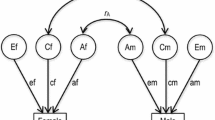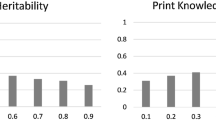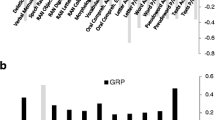Abstract
Inverse Bayesian analyses were applied to data from three large family studies of reading disability to estimate the posterior probability that an offspring will be affected, given that a parent reported a history of learning problems. Prior analyses presented elsewhere (Pennington et al., 1990), suggest that family transmission in these three studies is consistent with major gene or polygene influence. Posterior probability rates are presented in this paper for male to female sex ratios of 3.5:1 and 1:1, with population incidences estimated at 0.05 and 0.10. Results indicate that offspring risk rates are significantly elevated if a parent reports a history of RD. Specifically, an offspring's risk was increased 2 to 80 times over population expectancies when there was an affected parent. While the posterior probabilities and relative risk rates were fairly similar across studies, there was also some variation, which may reflect the different genetic mechanisms operating in these families. This study concludes that both absolute and relative risks are sufficiently increased in families with RD parents to warrant use of family history as a component in clinical evaluation. It is also evident from these results that consideration of the apparent mode of genetic transmission in families may provide even better information as to offspring risk, when family history is obtained.
Similar content being viewed by others
References
American Psychiatric Association. 1987. Diagnostic and statistical manual of mental disorders (3rd edition-Revised). Washington D.C.: APA Press.
DeFries J. C., Olson R. K., Pennington B. F., and Smith S. D. 1991. The Colorado Reading Project: An update. In D. B. Gray and D. Duane (Eds.), The reading brain: The biological basis of dyslexia. Parkton, MA: York Press.
DeFries J. C. and Decker S. 1982. Genetic aspects of reading disability: A family study. In R. N. Malatesha and P. G. Aaron (Eds.), Reading disorders: Varieties and treatments. New York: Academic Press.
DeFries, J. C., Vogler, G. P., and LaBuda, M. 1986. Colorado Family Reading Study: An overview. In J. Fuller and E. Simmel (Eds.), Perspectives in behavior genetics, Principles and Application II, Hillsdale, N.J.
DeRuiter J. A., Ferrell W. R., and Kass C. E. 1975. Learning disability classification by Bayesian aggregation of test results. Journal of Learning Disabilities, 8, 365–372.
Dworkin P. H. 1985. Learning and behavior problems of school children. Philadelphia, PA: W.B. Saunders Co.
Finnuci J. M., Isaacs S. D., Whitehouse C. C., and Childs B. 1982. Empirical validation of reading and spelling quotients. Developmental Medicine and Child Neurology, 24, 733–744.
Gilger, J. W. 1990a. Reading disorders in families: Genetics and development. Unpublished manuscript.
Gilger, J. W. 1990b. Using self-report and parental-report data to assess past and present academic achievement of adults and children. Submitted for review.
Gilger, J. W., Geary, D. C., and Eisele, L. 1990. Reliability and validity of retrospective self-reports of pubertal events using twin, sibling, and college student data. Adolescence, In press.
Hieronymous A. N. and Hoover H. D. 1986. Manual for school administrators for the ITBS. Chicago, Ill: Riverside Publishing Co.
Iowa Testing Program 1987. Manual for teachers, administrators and counselors for the ITED. Iowa City, IA: The University of Iowa.
Lewis A. 1980. The early identification of children with learning difficulties. Journal of Learning Disabilities, 13, 102–108.
Lindgren S. D., Richman L., and Eliason M. 1986. Memory processes in reading disability subtypes. Developmental Neuropsychology, 2, 173–181.
Pennington, B. F., Gilger, J. W., Pauls, D., Smith, S. A., Smith, S. D., and DeFries, J. C. 1990. Segregation analyses of four samples of dylsexic families. Submitted for review.
Pennington B. F. and Smith S. D. 1988. Genetic influences on learning disabilities: An update. Journal of Consulting and Clinical Psychology, 56, 817–823.
Pennington B. F., Smith S. D., McCable L. L., Kimberling W. J., and Lubs H. A. 1984. Developmental continuities and discontinuities in a form of familial dyslexia. In R. Emde and R. Harman (Eds.), Continuities and discontinuities in development (pp. 123–151) New York: Plenum Press.
Richman L. 1983. Language-Learning Disability: Issues, research, and future directions. Advances in Developmental and Behavioral Pediatrics, 4, 87–107.
Satz P. and Friel J. 1974. Some predictive antecedents of specific reading disability: A preliminary two-year follow-up. Journal of Learning Disabilities, 7, 437–444.
Satz P., Taylor H. G., Friel J., and Fletcher J. 1978. Some development and predictive precursors of reading disabilities: A six year follow-up. In A. L. Benton and D. Pearl (Eds.), Dyslexia: An appraisal of current knowledge (pp. 313–348). New York: Oxford University Press.
Schulman J. and Leviton A. 1978. Reading disabilities: An epidemiologic approach. In H. R. Mykelbust (Ed.), Progress in learning disabilities (vol. 4, pp. 65–96). New York: Grune & Stratton.
Shaywitz S. E., Shaywitz B. A., Fletcher J. M., and Escobar M. D. 1990. Prevalence of reading disabilities in boys and girls: Results of the Connecticut Longitudinal Study. Journal of the American Medical Association, 264(8), 998–1002.
Smith S. D., Kimberling W. J., Pennington B., and Lubs H. A. 1983. Specific reading disability: Identification of an inherited form through linkage analysis. Science, 219, 1345–1347.
Smith, S. D., Pennington, B. F., Kimberling, W. J., Fain, P. R., Ing, P. S., and Lubs, H. A. 1986. Genetic heterogeneity in specific reading disability. American Journal of Human Genetics, 39, A169.
Vogler G. P., DeFries J. C., and Decker S. 1985. Family history as an indicator of risk for reading disability. Journal of Learning Disabilities, 18, 419–421.
Winkler R. L. 1972. Introduction to Bayesian inference and decision. New York: Holt, Rinehart & Winston.
Wissink J. Kass C. E., and Ferrell W. R. 1975. A Bayesian approach to the identification of children with learning disabilities. Journal of Learning Disabilities, 8, 158–166.
Author information
Authors and Affiliations
Rights and permissions
About this article
Cite this article
Gilger, J.W., Pennington, B.F. & Defries, J.C. Risk for reading disability as a function of parental history in three family studies. Reading and Writing: An Interdisciplinary Journal 3, 205–217 (1991). https://doi.org/10.1007/BF00354958
Issue Date:
DOI: https://doi.org/10.1007/BF00354958




